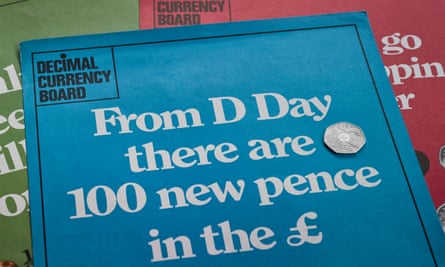‘D Day’: UK marks 50 years since decimalisation
It’s 50 years since the UK’s currency went decimal, ditching tanners, shillings and florins and introducing new coins including the 1p piece.
The anniversary of Decimal Day on Monday 15 February 1971 marks when Britain finally moved to a system based on units of 10. Under the old system, which had been in place for hundreds of years, there were 12 pence in a shilling and 20 shillings, or 240 pence, in a pound.
Other countries had already moved to decimalisation, and Britain had been considering a change since the 1820s, with a Decimal Association lobbying for a new currency from 1841.
 View image in fullscreenLord Fiske visits Marks & Spencer in London’s Edgware Road to help change over the prices to decimal currency. Photograph: PA
View image in fullscreenLord Fiske visits Marks & Spencer in London’s Edgware Road to help change over the prices to decimal currency. Photograph: PA
In 1847, the MP John Bowring argued in the House of Commons that the reasons for a decimal system were so obvious it should no longer be delayed. Hansard reports Bowring arguing: “Every man who looked at his 10 fingers saw an argument for its use, and an evidence of its practicability.”
But it was only in 1966 that the country agreed to switch. The decision was announced by the then chancellor, James Callaghan, who described it as “a momentous and an historic decision” that would “bring considerable benefit to the economy at large”.
He announced a five-year period for the changeover to be arranged, and said the Treasury would meet half of the cost, which was likely to be less than £120m. The Decimal Currency Act was passed in 1969.
The long buildup ensured a smooth transition. The chair of the Decimal Currency Board, Lord Fiske, had said he hoped it would be “the non-event of 1971” and he got his wish.
The first decimal coins were issued in 1968, to give shoppers a chance to get used to them before the old system was scrapped. It was a weird introduction – the new five pence pieces were the same size as a shilling and worth the same, yet there was the potential for confusion because they were not worth five old pence. BBC reports show some people preferred to stick to the old coins.
 View image in fullscreenAlice Robinson, who closed her general store because of decimalisation. ‘I can’t be bothered with this new money,’ she said. ‘Six robberies in five years couldn’t close me, but this new money has. I know the old system and I’m not going to fiddle about with any new one.’ Photograph: PA
View image in fullscreenAlice Robinson, who closed her general store because of decimalisation. ‘I can’t be bothered with this new money,’ she said. ‘Six robberies in five years couldn’t close me, but this new money has. I know the old system and I’m not going to fiddle about with any new one.’ Photograph: PA
But the preparations for “D Day” seemed to have put the country in good stead for the changeover. Banks had trained their staff to deal with the new currency, and held talks for members of the public. NatWest alone delivered 3,000 presentations by June 1970 to groups including the Women’s Institute.
It also produced a monthly Decimal Currency Digest which it sent to staff, and cashiers had to read four booklets and complete six training exercises to make sure they understood the new systems.
The country’s banks all closed for the Thursday and Friday before – this was a time when they were already closed at the weekend – to convert accounts. The Stock Exchange closed, and on the Friday Post Offices were shut.
The Royal Mint spent years producing millions of new coins, and these were distributed to banks around the country ahead of the switch.
 View image in fullscreenLeaflets produced by the Decimal Currency Board alongside a 50p coin issued by the Royal Mint for the 50th anniversary of Decimal Day. Photograph: The Royal Mint/PA
View image in fullscreenLeaflets produced by the Decimal Currency Board alongside a 50p coin issued by the Royal Mint for the 50th anniversary of Decimal Day. Photograph: The Royal Mint/PA
Before and after D Day, shops carried posters with the prices in old and new money. On the day itself, these were switched, so the new prices were shown first. The new 1/2p, 1p and 2p coins came into circulation, to join those that had already been introduced.
The next day, the Guardian reported that generally things had gone smoothly: “The fear of confusion as travellers and shoppers met the new bronze coins for the first time proved unfounded.”
However, it said there was some “chicanery” as people realised the new 1p coin could be used to buy things that used to cost more than twice as much.
“Within an hour or so of its official introduction the coin was being used by quicker-thinking citizens to feed slot machines geared to the 6d piece.”



